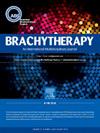加拿大近距离放射治疗经验:加拿大近距离放射治疗小组全国调查结果。
IF 1.8
4区 医学
Q4 ONCOLOGY
引用次数: 0
摘要
目的/目标:近距离放射治疗(BT)技术、技能和资源需求在过去十年中取得了进步。本研究旨在描述目前加拿大BT的可用性、专业知识和利用程度。材料和方法:一份68个问题的调查,涵盖了专业知识、培训、资源和BT项目未来的挑战,并发送给加拿大49个放射治疗中心中的36个,每个中心都有一个代表,确定有一个活跃的BT项目。然后对回复进行总体分析。结果:获得31份回复(回复率86%),代表了至少有1个可用BT项目的所有省份(9个)。每个中心从事BT治疗的放射肿瘤学家中位数为5人(3-6人);这代表了每个中心33%(24%-43%)的劳动力。30个(97%)中心至少有1名近距离治疗师。11个(35%)被调查中心提供BT奖学金项目,7个(64%)在培训结束时提供国家认可的近距离治疗指定。所有30名受访者(100%)对子宫内膜癌、26名(87%)对宫颈癌、25名(83%)对前列腺癌和20名(67%)对阴道癌进行了BT治疗。2024年,子宫内膜癌、宫颈癌、前列腺癌和阴道癌的治疗中位数分别为38例(22-50)、19例(7-33)、66例(41-138)和1例(0-3)。16位(62%)受访者预计未来5年内对BT资源的需求将会增加。结论:加拿大各地的BT项目得到了训练有素的短程治疗师的支持。BT项目最常用于治疗妇科和泌尿生殖系统恶性肿瘤。本文章由计算机程序翻译,如有差异,请以英文原文为准。
The Canadian brachytherapy experience: Results of the Canadian brachytherapy group national survey
Purpose/Objective
Brachytherapy (BT) techniques, skillsets and resource requirements have advanced over the past decade. This study aimed to characterize the current extent of BT availability, expertise and utilization in Canada.
Materials and Methods
A 68-question survey covering expertise, training, resources and future challenges to BT programs was created and sent to a single representative at each of the 36 of 49 radiotherapy centers in Canada identified to have an active BT program. Responses were then analyzed in aggregate.
Results
Thirty-one responses (response rate 86%) representing all provinces with at least 1 available BT program (9) were obtained. The median number of radiation oncologists practicing BT in each center was 5 (3-6); this represented 33% (24%–43%) of the workforce at each center. Thirty (97%) centers had at least 1 fellowship trained brachytherapist on site. Eleven (35%) respondent centers offered BT fellowship programs and 7 (64%) of those offered the nationally accredited brachytherapy designations at the end of training.
All 30 respondents (100%) offered BT treatment for endometrial cancer, 26 (87%) for cervical cancer, 25 (83%) for prostate cancer and 20 (67%) for vaginal cancer. In 2024, the median number of endometrial, cervical, prostate and vaginal cancers cases treated were 38 (22–50), 19 (7–33), 66 (41–138) and 1 (0–3), respectively. Sixteen (62%) respondents anticipated an increase in demand for BT resources within the next 5 years.
Conclusion
BT programs across Canada are supported by highly trained brachytherapists. BT programs most commonly treat gynecologic and genitourinary malignancies.
求助全文
通过发布文献求助,成功后即可免费获取论文全文。
去求助
来源期刊

Brachytherapy
医学-核医学
CiteScore
3.40
自引率
21.10%
发文量
119
审稿时长
9.1 weeks
期刊介绍:
Brachytherapy is an international and multidisciplinary journal that publishes original peer-reviewed articles and selected reviews on the techniques and clinical applications of interstitial and intracavitary radiation in the management of cancers. Laboratory and experimental research relevant to clinical practice is also included. Related disciplines include medical physics, medical oncology, and radiation oncology and radiology. Brachytherapy publishes technical advances, original articles, reviews, and point/counterpoint on controversial issues. Original articles that address any aspect of brachytherapy are invited. Letters to the Editor-in-Chief are encouraged.
 求助内容:
求助内容: 应助结果提醒方式:
应助结果提醒方式:


